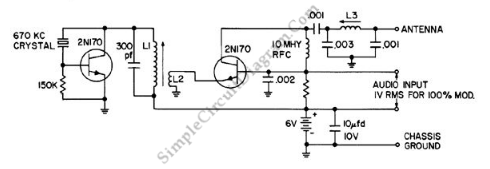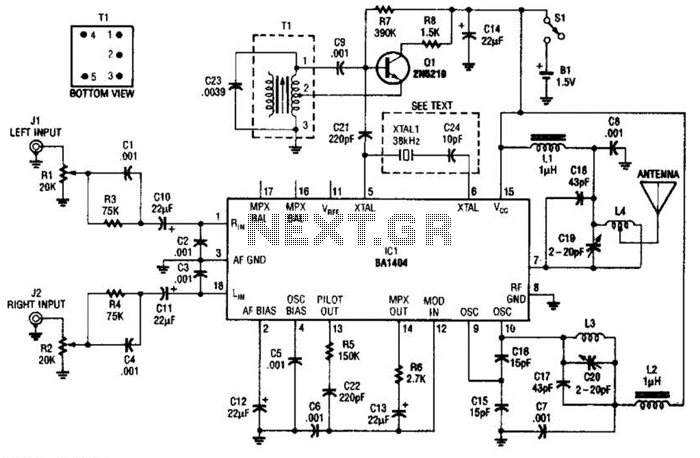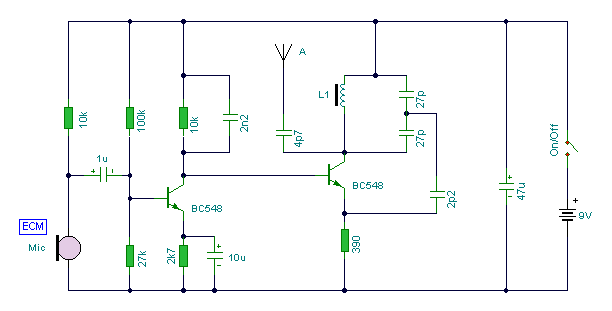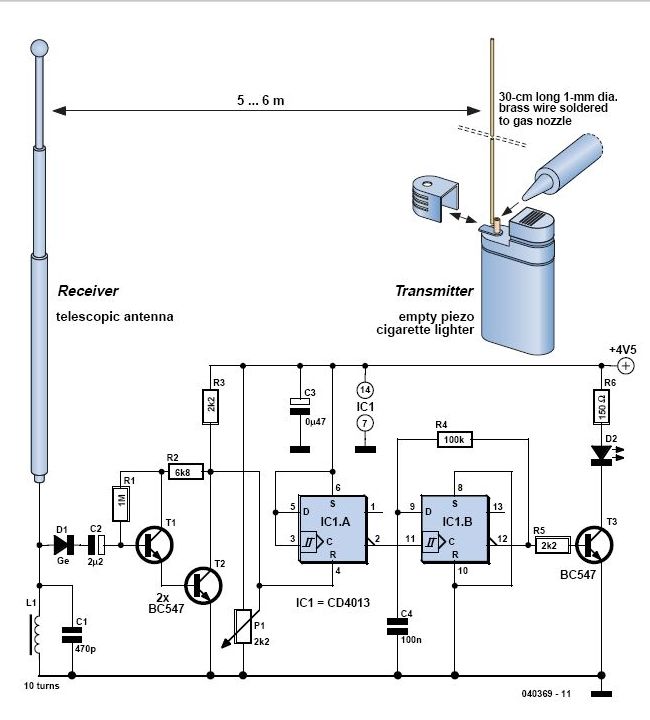
Small Broadcast-Band AM Transmitter

This AM radio circuit is a low-power transmitter operating in the broadcast band. Its simplicity is achieved through the use of a single-transistor amplifier stage.
The AM radio transmitter circuit operates within the standard AM broadcast band, typically ranging from 530 kHz to 1700 kHz. The core of the circuit is a single-transistor amplifier, which serves to modulate the audio signal onto the carrier frequency.
The circuit begins with an audio input, which could be sourced from a microphone or an audio playback device. This audio signal is then fed into the base of the transistor, which functions as a modulator. The transistor is configured in a common emitter mode, providing both amplification and phase inversion of the input signal.
A key component of the circuit is the LC tank circuit, which consists of an inductor and a capacitor. This tank circuit is essential for determining the frequency of the transmitted signal. The values of the inductor and capacitor must be carefully selected to resonate at the desired frequency within the AM band.
The output of the transistor is connected to an antenna, which radiates the modulated signal into the surrounding environment. The efficiency of the antenna can significantly affect the transmission range of the circuit. A simple wire antenna can be used, but its length should be approximately one-quarter of the wavelength of the desired transmission frequency for optimal performance.
Power supply requirements for this low-power transmitter are minimal, often operating from a standard battery or low-voltage power source. Proper biasing of the transistor is crucial for ensuring linear amplification and preventing distortion of the audio signal.
Overall, this AM radio transmitter circuit exemplifies a straightforward yet effective design for broadcasting audio signals, suitable for educational purposes or hobbyist projects. The use of a single-transistor amplifier simplifies construction while still achieving functional performance within the AM broadcast band.This AM radio circuit is a low power transmitter working on broadcast band. The simplicity is implemented using a single-transistor amplifier stage, and for.. 🔗 External reference
The AM radio transmitter circuit operates within the standard AM broadcast band, typically ranging from 530 kHz to 1700 kHz. The core of the circuit is a single-transistor amplifier, which serves to modulate the audio signal onto the carrier frequency.
The circuit begins with an audio input, which could be sourced from a microphone or an audio playback device. This audio signal is then fed into the base of the transistor, which functions as a modulator. The transistor is configured in a common emitter mode, providing both amplification and phase inversion of the input signal.
A key component of the circuit is the LC tank circuit, which consists of an inductor and a capacitor. This tank circuit is essential for determining the frequency of the transmitted signal. The values of the inductor and capacitor must be carefully selected to resonate at the desired frequency within the AM band.
The output of the transistor is connected to an antenna, which radiates the modulated signal into the surrounding environment. The efficiency of the antenna can significantly affect the transmission range of the circuit. A simple wire antenna can be used, but its length should be approximately one-quarter of the wavelength of the desired transmission frequency for optimal performance.
Power supply requirements for this low-power transmitter are minimal, often operating from a standard battery or low-voltage power source. Proper biasing of the transistor is crucial for ensuring linear amplification and preventing distortion of the audio signal.
Overall, this AM radio transmitter circuit exemplifies a straightforward yet effective design for broadcasting audio signals, suitable for educational purposes or hobbyist projects. The use of a single-transistor amplifier simplifies construction while still achieving functional performance within the AM broadcast band.This AM radio circuit is a low power transmitter working on broadcast band. The simplicity is implemented using a single-transistor amplifier stage, and for.. 🔗 External reference
Warning: include(partials/cookie-banner.php): Failed to open stream: Permission denied in /var/www/html/nextgr/view-circuit.php on line 713
Warning: include(): Failed opening 'partials/cookie-banner.php' for inclusion (include_path='.:/usr/share/php') in /var/www/html/nextgr/view-circuit.php on line 713


.jpg)

